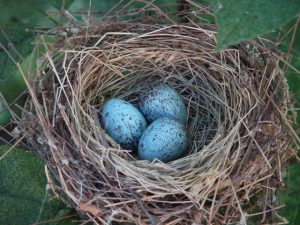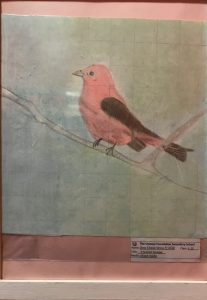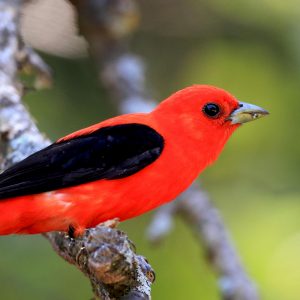| Common Name | (in English) Scarlet Tanager |
| (in Chinese) 猩紅麗唐納雀 | |
| Scientific Name | (in Latin) Piranga olivacea |
| Peculiar characteristics / external features: | Scarlet Tanagers are a beautifully colored bird. The male’s breeding plumage is red on the body and black on the wings and tail.Scarlet Tanagers are unusual among the 230 species of the Neotropical tanager family because they have seasonal changes in plumage. Only one other tanager, a South American species, does this. Females, immature males, and winter males have an olive colored back, yellow underside, and brownish wings. Adult birds are approximately 7 inches (18 cm) long. |
| Distributions: | The range of the Scarlet Tanager extends from southeastern Canada to the southern United States and from the east coast to the mid-west.
The primary habitat of the Scarlet Tanager is a mixed deciduous forest interspersed with hemlocks and pines. Scarlet Tanagers also inhabit urban parks and suburban areas with large trees. Within these areas, a Scarlet Tanager is most commonly found in oak trees, which they use during feeding, breeding, and nesting. |
| Habits: | |
| l Dietary | Insects are the primary food preference of the Scarlet Tanager. Most often the Scarlet Tanager moves slowly through tree tops searching for beetles and caterpillars; however they do feed on other insects as well like bees, wasps, and butterflies. They even are known to feed on fruits and buds, but primarily as a supplement in their insectivorous diet. |
| l Reproductive (Solitary/Social/Territorial, Courtship Behavior, Taking care of youngs, etc) | Tanager nests can be situated between four and seventy-five feet above ground on horizontal branches far from the trunks. Nests are constructed of loosely woven twigs and roots and are lined with grass and weed stems.
Breeding occurs from May to August with the males performing courtship displays low in the branches as the females watch from above. The male’s display is with the wings held drooping slightly away from the body with elongated necks allowing for their scarlet backs to be seen. Three to five, usually four, eggs, which are greenish with brown spots, are laid. The female incubates the eggs for thirteen or fourteen days. After hatching, the male assists in feeding the young. |
| l Whatever appropriate | Adult scarlet tanagers are eaten by birds of prey, including various owls. Eggs and nestling predators include blue jays, grackles, American crows, squirrels, chipmunks, and snakes.
Scarlet tanagers mob most predators, diving and swooping around them while calling at them. However, scarlet tanagers respond to American crows and merlins by becoming quiet and watchful, apparently in an attempt to be inconspicuous. Scarlet tanagers eat insects that some humans may consider to be pests. Unfortunately, like so many migratory birds the Scarlet Tanager is facing a decline in numbers as they continue to lose habitat on both their breeding and wintering grounds. Scarlet Tanagers are also subject to the influences of climate change and collision with towers. |
| Interesting Fact: | Males usually arrive from their winter stay in South America slightly before the females and stake out territories in choice tall trees. To warn the other males away, each sings frequently from his own spot with songs such as :”querit, queer, queery, querit, queer” along with the call note “CHIP-churr or CHICK-bur”. Females are attracted to the singing males, who court potential mates by hopping about on low perches in woods near the ground, spreading their wings and displaying their scarlet backs. The males often feed their partners as the nesting season approaches. |
References:
https://www.nationalgeographic.com/animals/birds/s/scarlet-tanager/
http://www.audubon.org/field-guide/bird/scarlet-tanager
https://www.nps.gov/shen/learn/nature/scarlet-tanager.htm





